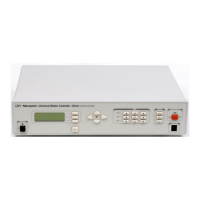5.2.12 Maximum Velocity
The Maximum Velocity that could be used in a motion control
system is determined by both motion device and driver. Usually it
represents a lower value than the motor or driver is capable of. In
most cases, including the ESP300, the default Maximum Velocity
should be increased. The hardware and firmware are tuned for a
particular maximum velocity that cannot be exceeded.
5.2.13 Minimum Velocity
The Minimum Velocity usable with a motion device depends on the
motion control system but also on the acceptable velocity regulation.
First, the controller sets the slowest rate of motion increments it can
make. The encoder resolution determines the motion increment size
and then, the application sets a limit on the velocity ripple.
To illustrate this, take the example of a linear stage with a resolution
of 0.1 µm. If the user sets the velocity to 0.5 µm/sec, the stage will
move 5 encoder counts on one second.
But, a properly tuned servo loop could move the stage 0.1 µm in
about 20 ms. The position and velocity plots are illustrated in
Figure
5.12.
1s
position
velocity
average
velocity
Figure 5.12: Position, Velocity and Average Velocity
The average velocity is low but the velocity ripple is very high.
Depending on the application, this may be acceptable or not. With
increasing velocity, the ripple decreases and the velocity becomes
smoother.
This example is even more true in the case of a stepper motor driven
stage. the typical noise comes from a very fast transition from one
step position to another. The velocity ripple in that case is
significantly higher.
Section 5 – Motion Control Tutorial 5-11

